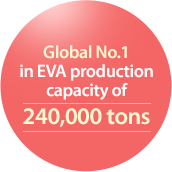Competitiveness Founded upon Innovation

The World’s Most Widely Used EVA Sheet for Solar Batteries is Made by Hanwha
Solar power is becoming more a promising environmentally-friendly source of energy, as cutting greenhouse gas has become the talk of the world. In 2016, the installed solar photovoltaics(PV) capacity reached 302 GW globally, a 32.7 percent growth year over year.
Solar PV panels collect sunlight and convert it into electricity or heat. The technology behind it involves the solar module whose structure is comprised of 5 layers. The first layer on the top is the glass layer and below it is the first of two encapsulant layers. The next and 3rd layer is the cell (battery) layer and then again an encapsulant layer. The last and 5th layer at the bottom is the backsheet. All combined the layers make up the solar module that can absorb sunlight. The encapsulant is the module’s core material ? it is a sheet that is only 0.5mm thin and it wraps around the cell. While deceptively thin, the encapsulant it is, however, critically needed to insulate the cells and protect them from moisture and external shock. One of the main components of encapsulants that has been widely used for the last 30 years has been ethylene vinyl acetate (EVA).
Hanwha Total Petrochemical has been leading the efforts to develop EVA and even adding value to it so that its products can be differentiated from competitive offerings. Hanwha’s relentless R&D to innovate and raise the bar for quality has been met with great success. Hanwha Petrochemical is producing 240 thousand tons of EVA whose quality is unrivaled in the industry. The company’s EVA has captured 35 percent of the lucrative global market ? the largest share in the world.



Hanwha Succeeds in the Commercial Production of EVA
with 28% VAM Content Using the World’s First Tubular Process
To understand the success of Hanwha’s EVA, we must first understand the product classifications and then the processes.
There are two different types of EVA cells, those classified as general purpose that use low Vinyl Acetate Monomer (VAM) content and those classified as premium that use high VAM cells. Solar cell encapsulants used in solar PV panels contain high VAM counts and the higher the count, the better. Hanwha Total Petrochemical’s high-value-added EVA registers approximately 28 percent VAM.



There are also two types of EVA production processes. One is the tubular reactor process and the other is the container-shaped autoclave process. Production of EVA requires an ultra-high temperature that is at least 446 degrees Fahrenheit and a reactor pressure of at least 2,500 bars. Small-scale pilot plants that can support these extreme operating conditions for the tubular process are very expensive to build. As a result, large-scale commercial plants struggle to get reliable data needed for pilot productions. This is why many EVA manufacturers opt for the autoclave process, which makes high-value EVA manufacturing easier, even though it is much less efficient than the tubular reactor process.
To develop EVA with higher VAM content, the R&D team at Hanwha Total Petrochemical took the unconventional approach by using the tubular process.
The R&D team of Hanwha Total Petrochemical applied its experience in fabricating high-quality low-density polyethylene (LDPE) and polymerization with the tubular process, they discovered a new formulation for polymerization. And as an alternative to building an actual pilot plant, the team created a program that could simulate and test the tubular process in a pilot plant.

The tubular process hardly allows any product development because the technology does not allow for pre-evaluating the product through pilot plants nor prepare small samples for testing. To solve for this limitation, our research team has identified the optimal polymerization conditions and developed a production technology that allows for small-scale pilot production and a simulator built in-house that can be used for process analysis and product design.



Recently, in 2016, Hanwha Total Petrochemical's EVA won the title of World Class Product of Korea¹ and also awarded the IR52 Jang Yeong-sil Award². The product stood out amongst the other EVAs in the global market for its high-quality. The EVA from Hanwha represents the company’s endless drive to innovate in the global petrochemical industry and its commitment to never stop improving quality to differentiate itself from competitors.
- ¹ World Class Product of Korea (selected by the Ministry of Commerce, Industry and Energy)
The award is given to companies whose product(s) rank at least 5th or hold a minimum share of 5% of the global market and meet at least one of the following requirements:
1) global market exceeds $50 million in size
2) annual revenue from exports exceeds $5 million - ² IR52 Jang Yeong-sil Award (sponsored by Korea Industrial Technology Association)
Award for products that are successfully developed and commercialized through the application of new technology. The Award is also given to organizations that lead innovation in industrial technology.
Get the latest news about Hanwha, right in your inbox.
Fields marked with * are mandatory.
- Non-employee
- Employee


